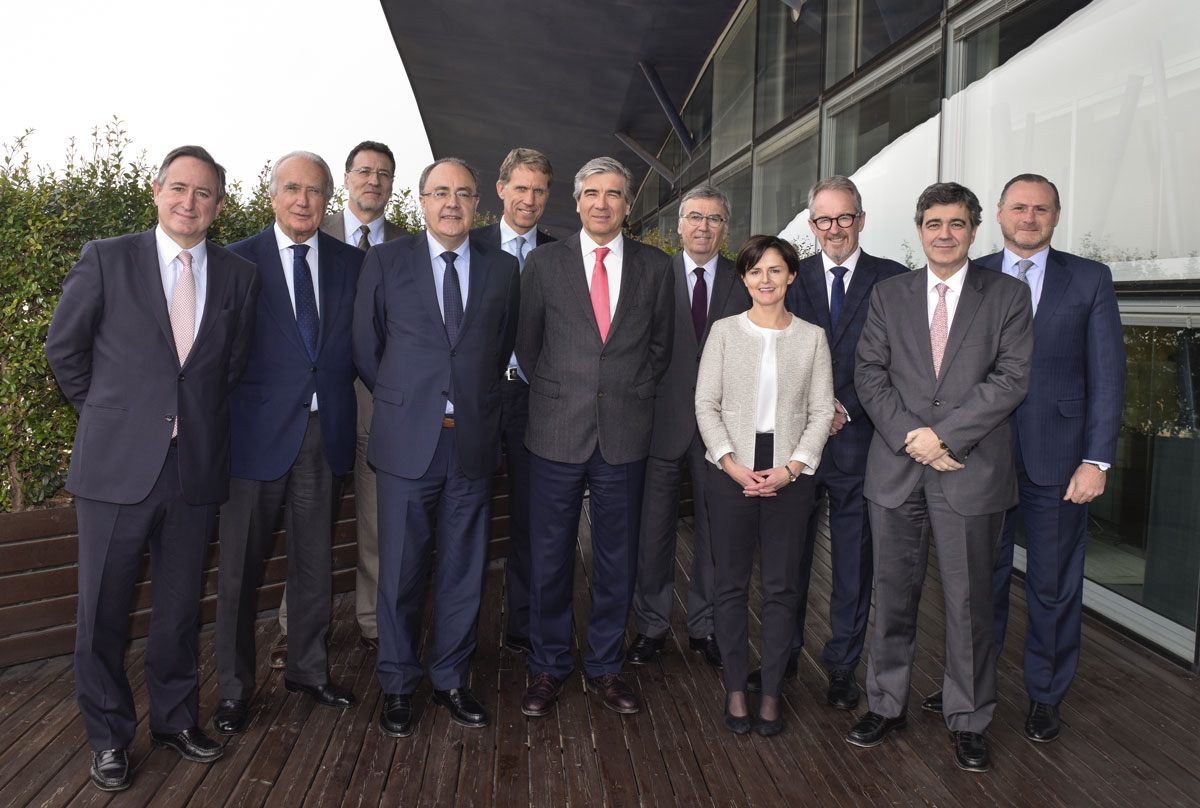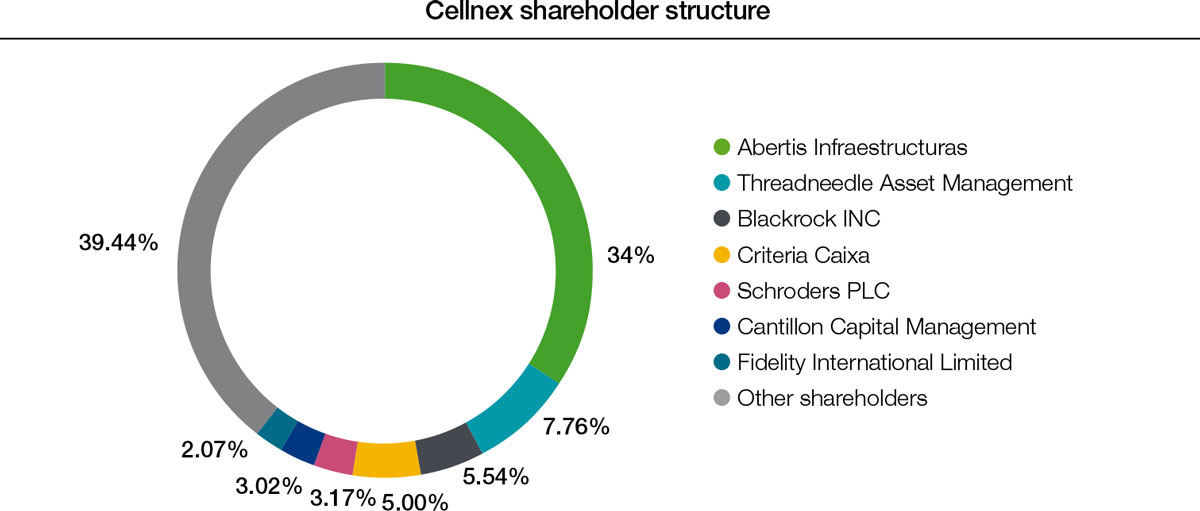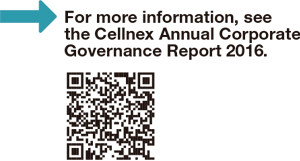Cellnex currently has a Board of Directors that is compact, experienced and oriented towards rolling out the strategy.
In 2016 Cellnex continued working to implement and consolidate the best corporate governance practices, covered essentially in the Code of Good Corporate Governance for Listed Companies approved by the Spanish National Securities Market Commission (CNMV) on 18 February 2015. Consequently, this alignment governs the rules that regulate the workings of the company’s governing bodies, the highest instance of which is the Board.
Cellnex currently has a Board of Directors that is compact, experienced and oriented towards rolling out the strategy, with four proprietary directors and four independent directors, besides the CEO.

Among the adjustments made during 2016 we would highlight:
- Approval of a Selection policy for directors which states that any implicit bias in the process of selecting candidates that might imply discrimination shall be avoided; that it will promote the formation of a gender-balanced Board of Directors; and that it must ensure that the less-represented gender makes up at least thirty percent of the total members of the Board of Directors, as soon as possible, and before the end of 2020. Promoting gender diversity is also a principle laid down in the Terms of Reference of the Board of Directors.
- The company has begun a selection process to include a new independent director. This process is subject to approval by the General Shareholders’ Meeting.
- Three proprietary directors were re-elected during this same financial year.
- The Policy of communication and contacts with shareholders, institutional investors and voting advisors was approved in accordance with the principles of transparency, equal treatment, continuous information, affinity with the corporate interest and regulatory compliance. Available on the corporate website.
- A new Internal Code of Conduct in matters relating to securities markets was adopted. This is available on the corporate website.
- Approval of the Directors’ remuneration policy by the Shareholders’ Meeting of 30 June 2016, valid for 2016 and the following three years. Also available on the corporate website.
- Amending of the Bylaws to bring in changes modifications for reasons of expediency to facilitate the attendance of shareholders at meetings, reducing the number of shares required for attendance from 1,000 to 100. Changes have also been made pursuant to the provisions in the legislation in force or in the Rules governing the General Shareholders’ Meeting or in the Terms of Reference of the Board of Directors. Company bylaws available on the website.
- Amendments to the Terms of Reference of the Board of Directors, to introduce changes to the Law on the Auditing of Accounts.
- Changes to the Rules governing the General Shareholders’ Meeting to provide systematic consistency to the internal rules governing the organisation and functioning of the company and to adjust the wording to the legislation in force.
- A Corporate Responsibility Plan was defined for the period 2016-2020 as a tool to integrate all the ethical, environmental and social initiatives of the company. Furthermore, the Board of Directors approved the Corporate Responsibility Policy in 2016. This sets out the basic guidelines and lines of action on Cellnex’s Corporate Responsibility and for the entire Group, the main objective being to integrate it progressively into all internal systems and processes. The Policy is based on the international standards adopted as a regulatory framework: the Principles of the UN Global Compact, the UN Guiding Principles on Business and Human Rights, the core conventions of the International Labour Organization (ILO), the OECD guidelines for Multinationals, and also on the recommendations contained in ISO 26000 (Social Responsibility Guide) and standards of the Global Reporting Initiative (GRI).
- Adoption of the Fiscal Strategy to establish guidelines for the group.
These rules and updated regulations will supplement the policies and regulations currently in force by Cellnex to reinforce best practices in corporate governance.

THE BOARD OF DIRECTORS COMPRISES 9 DIRECTORS, FOUR OF WHOM ARE INDEPENDENT.
The Cellnex Board of Directors
Independent directors:
- Pierre Blayau, Chairman of Caisse Central Réassurance and independent director on the Boards of Directors of FIMALAC and the Canal + group;
- Bertrand-Boudewijn Kan, former Director General and Chairman of the European Telecommunications Group of investment bank Morgan Stanley. He is also a director in the listed company Síminn Hf.
- Leonard Peter Shore, former chairman of telecommunications infrastructure operator Arqiva (United Kingdom), former chairman of Pricelines.com, Uecomm Lonely Planet Publications and former CEO of Media/Communications/Partners.
- Giampaolo Zambeletti, Chairman of RCS Investimenti and vice-chairman of Unidad Editorial. Former executive director at Telecom Italia Int., Auna and Telekom Austria;
Proprietary directors:
- Francisco Reynés Massanet, Chairman. He is Vice-Chairman-CEO of Abertis Infraestructuras, S.A. and a Trustee of the Abertis private Foundation.
- Francisco José Aljaro, Chief Financial Officer and Corporate Development Officer at Abertis Infraestructuras, S.A.
- Josep María Coronas, Deputy Non-Executive Secretary, General Secretary and Corporate General Manager in Abertis Infraestructuras, S.A.
- Lluís Deulofeu, General Manager of Sanef Group (France), linked to Abertis Infraestructuras, S.A.
Executive Director:
- Tobías Martínez Gimeno, Chief Executive Officer of Cellnex
Non-Executive Secretary:
- Javier Martí de Veses, Secretary-General.
Deputy Non-Executive Secretary:
- Mary Annabel Gatehouse, Director for International Corporate Development Advice.
in 2016, the Board had worked efficiently, fulfilling the functions attributed to it in the Terms of Reference of the Board of Directors.
 In 2016, the Board conducted a self-assessment, which concluded that during the evaluation period, the Board had worked efficiently, fulfilling the functions attributed to it in the Terms of Reference of the Board of Directors. As an overall assessment, the directors identified the Board’s strengths as its dedication and commitment, independence and collaborative atmosphere, its strategic and financial vision and its alignment with Cellnex’s growth strategy (more information in ACGR 2016).
In 2016, the Board conducted a self-assessment, which concluded that during the evaluation period, the Board had worked efficiently, fulfilling the functions attributed to it in the Terms of Reference of the Board of Directors. As an overall assessment, the directors identified the Board’s strengths as its dedication and commitment, independence and collaborative atmosphere, its strategic and financial vision and its alignment with Cellnex’s growth strategy (more information in ACGR 2016).
Committees of the Board of Directors
Cellnex’s governance bodies are supplemented by the Audit and Control Committee (CAC) and the Appointments and Remuneration Committee (CNR), both composed of non-executive directors. Both are chaired by independent directors and a majority of members are independents.
The responsibilities and functioning of the Audit and Control Committee, and Appointments and Remuneration Committee, are set out in the Terms of Reference of the Board of Directors.





 In 2016, the Board conducted a self-assessment, which concluded that during the evaluation period, the Board had worked efficiently, fulfilling the functions attributed to it in the Terms of Reference of the Board of Directors. As an overall assessment, the directors identified the Board’s strengths as its dedication and commitment, independence and collaborative atmosphere, its strategic and financial vision and its alignment with Cellnex’s growth strategy (more information in ACGR 2016).
In 2016, the Board conducted a self-assessment, which concluded that during the evaluation period, the Board had worked efficiently, fulfilling the functions attributed to it in the Terms of Reference of the Board of Directors. As an overall assessment, the directors identified the Board’s strengths as its dedication and commitment, independence and collaborative atmosphere, its strategic and financial vision and its alignment with Cellnex’s growth strategy (more information in ACGR 2016).